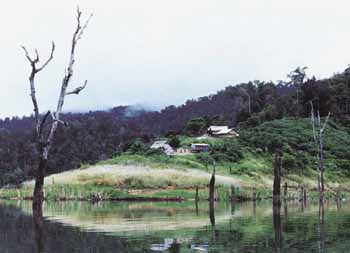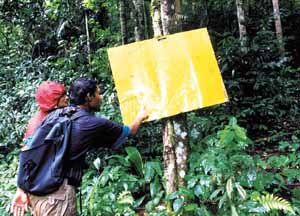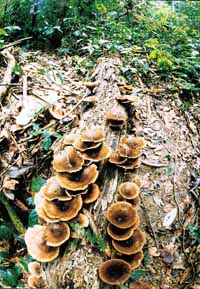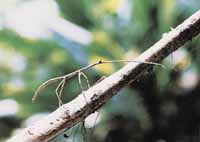Tuesday,
November 24, 1998
Environment
Reserved for nature
By Tan Cheng Li
THERE'S gold in them hills... Gold deposits have been known to occur in the hills and mountains of northern Perak. And gold seams found in Kelantan are said to stretch into the northernmost point of the state, within forested areas known collectively as Belum. In fact, villagers had in the past panned for gold in the upper reaches of Sungai Perak.
State officials later quashed the rumours, saying that a survey by the Malaysia Mining Corporation found only traces of gold, too little and too scattered to be economically mined.

An orang asli settlement by Temengor Lake. |
But what Belum definitely has is green gold -- in its towering, mature timber trees. Some 40 years of isolation because of the area's "restricted" status during and after the Communist insurgency, has kept it in an almost pristine state.
Thus, while scientists marvel at Belum's biological treasures, loggers see a forest ripe for harvesting. There has been no shortage of allegations of illegal logging in the remote site.
The latest controversy erupted early this month when members of the Malaysian Nature Society (MNS) found a noticed nailed on a tree indicating possible logging where the society had set up a camp when it conducted a scientific expedition there between 1993 and 1994.
The signboard bearing the words "Jabatan Perhutan Negeri Perak D. Ridzuan," listed the type of activity as "Pre-F" covering 2,000ha in the Temengor forest reserve. The contractor's name was given as Cenderla Ltd.
It was noted that some smaller trees lining the nearby Sungai Halong had red markings. Villagers say a bridge was being built across Sungai Tekam, presumably to bring out logs.
Perak Mentri Besar Tan Sri Ramli Ngah Talib later gave his assurance that no logging concessioned been issued for both Belum and Temengor forest reserves, although Temengor has been designated for logging many years ago. This, however, does little to allay fears among conservationists.
It may only be a matter of time before trees are felled. The notice on the tree says it all: the term "Pre-F" is a common abbreviation for "pre-felling," which refers to the survey done prior to logging. It entails identifying the trees to be felled and those to be retained for future growth. So Ramli's statement that the contractor was only doing a tree inventory, is puzzling indeed.
And even if it is Temengor forest reserve which is to be logged, and not Belum, that does not mean that all is well. For when scientists talk about the richness of Belum, they are actually referring to both Belum and Temengor forest reserves.

MNS scientific officers studying the notice indicating the possibility of logging in the reserve. |
In fact, the MNS base camp and the area surveyed during its scientific expedition was in Temengor forest reserve. Plans to survey Belum proper, mooted since 1993, did not materialise until May or June this year.
As results of the first expedition revealed, Temengor harbours a rich diversity of life; its preservation is thus, imminent.
This is one of the reasons behind MNS's proposal for a 300,000ha national or state park straddling the Belum and Temengor forest reserves.
Since it is impossible to preserve all forests, scientists generally suggest protecting representative areas. And the Belum-Temenggor site is the largest tract of mostly undisturbed forest remaining in the north. More importantly, it showcases the flora of the northern region, which has distinct Myanmar-Thai influences.
Thus, one important reason for conserving Belum is its geographical location, explains retired Universiti Malaya professor of zoology Dr Yong Hoi Sen, who participated in the second Belum expedition.
"Taman Negara houses the flora and fauna peculiar to the central region, while Endau-Rompin is home to species distinct to the south. By conserving Belum, we will protect the flora and fauna found in the northern region."
Exactly what kind of biological riches Belum proper has is as yet unrevealed. The state government insists that no findings be made public without it being informed first. But members of the second expedition were very much restricted by the Army -- Belum's closeness to the Thai border makes it a restricted, high-security area; thus they were unable to collect as much as they would have liked.
But Belum forest reserve (134,000ha) is even more pristine than Temengor (149,000ha); thus it may harbour even more biodiversity.
The area's importance as a conservation site was recognised as early as 1968, during the Colombo Plan which was the country's first in-depth study on protected areas. The Third Malaysia Plan (1976-80) also recommended conservation of Belum.
In 1988, the National Parks and Wildlife Department proposed that Belum be made a national park. But the status of Belum and Temengor remained unchanged, although both were gazetted as forest reserves in 1991.
Though Ramli said recently that a proposal for a state park in the area is now with the Economic Planning Unit of the Prime Minister's Department, details on the park's exact location are vague.
He initially told the press that the proposed 137,000ha park would include the Belum reserve and the western portion of Temengor.
In the later press reports, he said that the "high security" status of Belum would not change, and this would help preserve the fauna and flora there. He said the park would cover 60,000ha of Temengor, with another 2,000ha as an educational and scientific research centre.
So while many welcome the state's plan for a park, there are still uncertainties: Will the park include the Belum reserve, or does it only cover Temengor? If so, how large an area?
Preservation of both Temengor and Belum -- not just Belum -- is vital as together with the Grik forest reserve, they serve as water catchment for the Temengor Dam.
The dam and its reservoir -- which drowned over 150 sq km of forests, shrubs, grassland and agriculture plots when constructed in 1978 -- play a multi-function role.
Forest botanist Dr E. Soepardmo says the Temengor dam not only provides hydropower, but is also the headwater for Sungai Perak. By regulating the flow into Sungai Perak, it alleviates downstream flooding. It is also a major fisheries ground.

Fungi adds colour to a trail in Belum. |
"The least the area is disturbed, the better for wildlife conservation, water control and hydropower generation."
MNS scientific officer Herman Bernard Ganapathy says development, especially land clearing and logging, will jeopardise the lake's water quality.
"The steep slopes on surrounding land are highly susceptible to erosion. It will be costly to clean up a silted lake, not to mention the effect on aquatic life, upon which many depend for survival."
Policing Belum
Despite the Mentri Besar's repeated assurances, some quarters remain unconvinced that Belum's status as a "security zone" will accord it enough protection.
After all, allegations of illegal logging, animal poaching and even the presence of Thai hunters have trickled in over the years. And in the second expedition this year, members observed a silted Sungai Tiang within the supposedly "logging-free" Belum reserve.
Dr Soepardmo stresses the urgency of an immediate decision on whether to gazette Belum as a state or national park: "This will give the forest a legal status. Once gazetted as protected, nobody can do anything inside there."
As repeatedly stressed by conservationists, the status of "forest reserves" are precarious. If declared as "production forests," they can be logged.
Of course Temenggor reserve was logged some 50 years ago. But the forest has since regenerated, says MNS's Herman Bernard Ganapathy. "Logging the area will disrupt the forest ecology again."
Logging will fragment the Belum-Temengor forest, thus threatening the area's role as a habitat and gene bank for species.
While the MNS report on the first expedition says that the area is not exactly richer than other undisturbed sites, it does have newly discovered endemic species and many more could be expected. Its major strength, however, is its status as one of the largest blocks of undisturbed forests on the West Coast.
"A bigger, contiguous area means a more stable environment. This offers a better chance of survival for animals," says Dr Soepardmo.
The Belum-Temengor links to other forests is another important ecological factor. It forms a contiguous link with the monsoonal forest of Thailand and Burma. To the east is the main range and Kelantan. Connecting the forested areas of Temengor and Kelantan are several forest "corridors."

Nature's splendid handiwork... a stick insect blends in remarkably with the environment. |
These links are crucial, asserts MNS president Datuk Dr Salleh Mohd Nor: "Most of the surrounding lowland forests have been logged or cleared for agriculture, leaving these paths as the few remaining and crucial links for movement of genetic resources among dispersed populations of plants and animals. Logging activities may break the links between these forested areas."
The MNS report states that without Belum-Temengor, these areas would be isolated and, inevitably, would lose some of their present richers. It also raises doubts whether forest remnants which have been fragmented by logging, would have a large enough population of large vertebrates and some lowland species to be self-sustaining.
Though big is always better where conservation is concerned, many scientists are aware that it is still the prerogative of the state government to decide how large an area is to be protected.
And since the state refuses to be deprived of the green gold to be found in the forest, what matters is how trees will be felled.
Dr Saw Leng Guan of the Forest Research Institute of Malaysia stresses the importance of incorporating environmental considerations: "Chances of the forest recovering is better if the logging is low-intensity, but not with the intense logging which we see nowadays," says Dr Saw, a member of the first Belum expedition.
Dr Yong points out that logging, if done correctly, may actually enrich the forest. Selective logging -- where only trees of a certain size are felled and damage to soil is minimised -- opens up the tree canopy, thus allowing sunlight to fuel undergrowth.
These smaller plants will attract smaller herbivores, which in turn will attract the large animals. However, adds Dr Yong, logging opens up the forest, making it accessible to hunters.
Perhaps, the best for Belum and Temengor is to keep them intact. But reality dictates that the state would not want to be shortchanged of the possible revenue to be found among the trees.
Thus in its report on the first expedition which was handed to the state government in 1995, MNS highlighted the importance of zoning the land for multiple use.
It suggested a central development authority to set development policies and co-ordinate the sustainable management of resources in the area.
Instead of merely exploiting its natural resources, it said Belum-Temengor should be conserved to serve multiple uses. Belum is worth its weight in gold, but definitely not just of the yellow and green variety.
For more information about Belum and the battle to save it, visit the Malaysian Nature Society (Selangor branch) website at http://2020.net.my/mns/